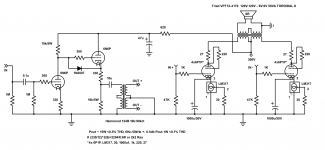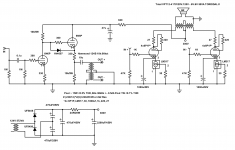Then your symbol is strongly misleading: You've marked the pins V+ (which most probably correlates to Vin), V- (assumingly Vout), and an arrow pointing into the device, respectively. As this arrow presumably means that a signal applied to this pin does somewhat within the device, it presumably has to be correlated to the Adj pin.
Best regards!
Best regards!
It's more of an estimate based on simulations with Push Pull Calculator, and simple measurements with a scope and a DDS. Output inverted and laid on top of input to leave only the distortion.
DDS? Digital........?........source...
I thought I'd add the final schematic complete with power supply. Enjoy. PS: I used this transformer and doubler because I bought it as surplus for 20$ CAD. The heaters are powered by a 12V 20A SMPS LED supply from ePay, and all wired in series pairs.
Attachments
Last edited:
Nothing wrong with voltage doublers and cheap transformers, they're a match made in heaven for builds like this! The SMPS is a great idea too. How is it on noise? I heard some can have high frequency hash issues.
You've really got me itching to do a big parallel 6P6S (6V6GT) build now, but I had 6N8S(6SN7) in mind for the next parallel build. Decisions decisions.
How does the power supply work out for him? You don't have much filtering but it doesn't take much with push pull outputs. I've had some issues with hum on doublers with triode connected builds in the past, and fixed it by going pentode mode with regulated screens, since I already had a regulator made up and ready, and wanted to try more power anyway.
I've got ten 6P6S with the same date code sitting here, and another four I could throw in, and eight "matched" 6N8S on the way, with another four on hand. Either way it's going to be AB2 capable with source followers... Do I want a big-@r$e baby amp, or a rock-the-house space heater? Either is tempting...
You've really got me itching to do a big parallel 6P6S (6V6GT) build now, but I had 6N8S(6SN7) in mind for the next parallel build. Decisions decisions.
How does the power supply work out for him? You don't have much filtering but it doesn't take much with push pull outputs. I've had some issues with hum on doublers with triode connected builds in the past, and fixed it by going pentode mode with regulated screens, since I already had a regulator made up and ready, and wanted to try more power anyway.
I've got ten 6P6S with the same date code sitting here, and another four I could throw in, and eight "matched" 6N8S on the way, with another four on hand. Either way it's going to be AB2 capable with source followers... Do I want a big-@r$e baby amp, or a rock-the-house space heater? Either is tempting...
Last edited:
No measurable hum or hash components, but you're right. Years ago I used an unfiltered, unshielded SMPS for heaters and figured out there was a 43.7kHz oscillation when I blew a pair of tweeters.
The driver is a CCDA so it doesn't need much filtering.
The switcher is good enough. It's a cheap eBay 20A supply and it starts into the cold heaters. It doesn't look like much filtering on B+ but the 24R/2200uF filter works surprisingly well. PSUD2 simmed it at under 150mV. There is no filter for the heaters other than the built in filtering caps in the SMPS.
FWIW I thought about building this with 6P3S instead but it wouldn't have fit in the chassis!
I went with the 15W output with triodes because I already built a KT120 amp that's around 100W with the 250VA Triad VPT18 series. This one was for transformer phase splitting and linearity while running in open loop.
The driver is a CCDA so it doesn't need much filtering.
The switcher is good enough. It's a cheap eBay 20A supply and it starts into the cold heaters. It doesn't look like much filtering on B+ but the 24R/2200uF filter works surprisingly well. PSUD2 simmed it at under 150mV. There is no filter for the heaters other than the built in filtering caps in the SMPS.
FWIW I thought about building this with 6P3S instead but it wouldn't have fit in the chassis!
I went with the 15W output with triodes because I already built a KT120 amp that's around 100W with the 250VA Triad VPT18 series. This one was for transformer phase splitting and linearity while running in open loop.
Last edited:
Thanks to you guys, I made the mistake of looking at 6P43P prices on Ebay, sixteen of them for just under $30 shipped 
I already have enough tubes! You guys are dirty enablers. Looking at the datasheets for the 6CW5/EL86 shows a possibly 25W at 1% THD for a 3000 ohm load. Sixteen of the things could make a very easy to drive 100W amplifier cheap! Assuming that the 6P43P is pretty close to the 6CW5 that's an insanely useful little tube. It would be a no brainer to grab some, and set aside for a similar build to this one. Cheap power toroids as outputs with such a low impedance make it cheap and easy!
Ugh. I need to order a chassis and mull over wether or not I should buy the tubes. You guys suck lol
I already have enough tubes! You guys are dirty enablers. Looking at the datasheets for the 6CW5/EL86 shows a possibly 25W at 1% THD for a 3000 ohm load. Sixteen of the things could make a very easy to drive 100W amplifier cheap! Assuming that the 6P43P is pretty close to the 6CW5 that's an insanely useful little tube. It would be a no brainer to grab some, and set aside for a similar build to this one. Cheap power toroids as outputs with such a low impedance make it cheap and easy!
Ugh. I need to order a chassis and mull over wether or not I should buy the tubes. You guys suck lol
Haha I know that feeling. You can power your new board with one of these and a 12V SMPS: DC-AC Converter 12V to 110V 200V 220V 280V 150W Inverter Boost Board Transformer | eBay
Also looks like a single pair of the 6P43P can do well into an Antek 2x115:12 100VA toroid, for an approximate 3015 ohm load, for about $21.60USD per channel. Not bad at all cost wise to get 25 watts out for about 40v peak-to-peak across both grids.
Might be new thread time...
Might be new thread time...
Last edited:
- Home
- Amplifiers
- Tubes / Valves
- The "Stupendous" 6P1P 4PP amplifier!

